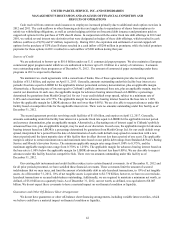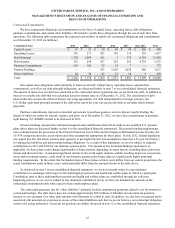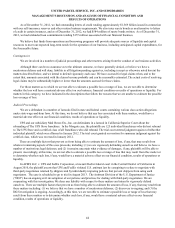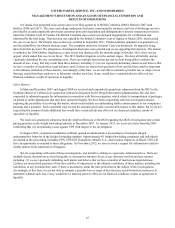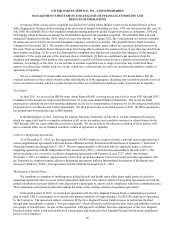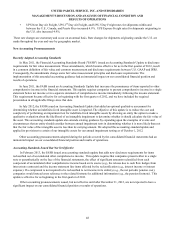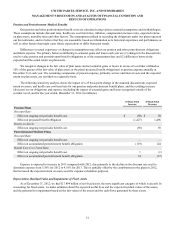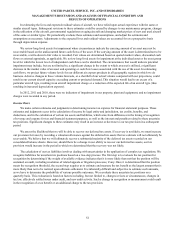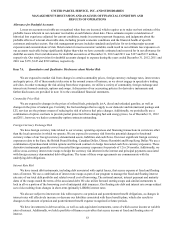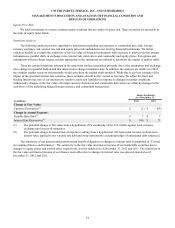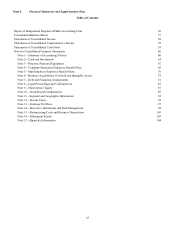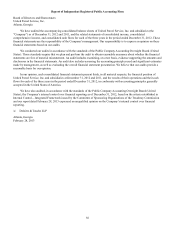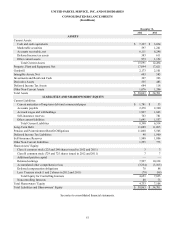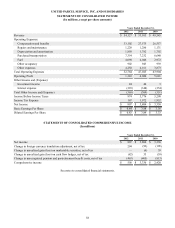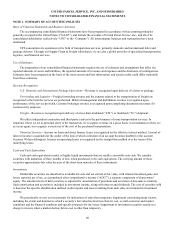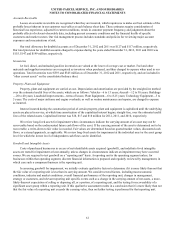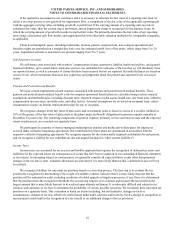UPS 2012 Annual Report Download - page 64
Download and view the complete annual report
Please find page 64 of the 2012 UPS annual report below. You can navigate through the pages in the report by either clicking on the pages listed below, or by using the keyword search tool below to find specific information within the annual report.UNITED PARCEL SERVICE, INC. AND SUBSIDIARIES
MANAGEMENT'S DISCUSSION AND ANALYSIS OF FINANCIAL CONDITION AND
RESULTS OF OPERATIONS
52
In estimating the lives and expected residual values of aircraft, we have relied upon actual experience with the same or
similar aircraft types. Subsequent revisions to these estimates could be caused by changes to our maintenance program, changes
in the utilization of the aircraft, governmental regulations on aging aircraft and changing market prices of new and used aircraft
of the same or similar types. We periodically evaluate these estimates and assumptions, and adjust the estimates and
assumptions as necessary. Adjustments to the expected lives and residual values are accounted for on a prospective basis
through depreciation expense.
We review long-lived assets for impairment when circumstances indicate the carrying amount of an asset may not be
recoverable based on the undiscounted future cash flows of the asset. If the carrying amount of the asset is determined not to be
recoverable, a write-down to fair value is recorded. Fair values are determined based on quoted market values, discounted cash
flows or external appraisals, as applicable. We review long-lived assets for impairment at the individual asset or the asset group
level for which the lowest level of independent cash flows can be identified. The circumstances that would indicate potential
impairment may include, but are not limited to, a significant change in the extent to which an asset is utilized, a significant
decrease in the market value of an asset and operating or cash flow losses associated with the use of the asset. In estimating
cash flows, we project future volume levels for our different air express products in all geographic regions in which we do
business. Adverse changes in these volume forecasts, or a shortfall of our actual volume compared with our projections, could
result in our current aircraft capacity exceeding current or projected demand. This situation would lead to an excess of a
particular aircraft type, resulting in an aircraft impairment charge or a reduction of the expected life of an aircraft type (thus
resulting in increased depreciation expense).
In 2012, 2011 and 2010, there were no indicators of impairment in our property, plant and equipment, and no impairment
charges were recorded in any period.
Income Taxes
We make certain estimates and judgments in determining income tax expense for financial statement purposes. These
estimates and judgments occur in the calculation of income by legal entity and jurisdiction, tax credits, benefits, and
deductions, and in the calculation of certain tax assets and liabilities, which arise from differences in the timing of recognition
of revenue and expense for tax and financial statement purposes, as well as the interest and penalties related to these uncertain
tax positions. Significant changes to these estimates may result in an increase or decrease to our tax provision in a subsequent
period.
We assess the likelihood that we will be able to recover our deferred tax assets. If recovery is not likely, we must increase
our provision for taxes by recording a valuation allowance against the deferred tax assets that we estimate will not ultimately be
recoverable. We believe that we will ultimately recover a substantial majority of the deferred tax assets recorded on our
consolidated balance sheets. However, should there be a change in our ability to recover our deferred tax assets, our tax
provision would increase in the period in which we determined that the recovery was not likely.
The calculation of our tax liabilities involves dealing with uncertainties in the application of complex tax regulations. We
recognize liabilities for uncertain tax positions based on a two-step process. The first step is to evaluate the tax position for
recognition by determining if the weight of available evidence indicates that it is more likely than not that the position will be
sustained on audit, including resolution of related appeals or litigation processes, if any. Once it is determined that the position
meets the recognition threshold, the second step requires us to estimate and measure the tax benefit as the largest amount that is
more likely than not to be realized upon ultimate settlement. It is inherently difficult and subjective to estimate such amounts,
as we have to determine the probability of various possible outcomes. We reevaluate these uncertain tax positions on a
quarterly basis. This evaluation is based on factors including, but not limited to, changes in facts or circumstances, changes in
tax law, effectively settled issues under audit, and new audit activity. Such a change in recognition or measurement could result
in the recognition of a tax benefit or an additional charge to the tax provision.


